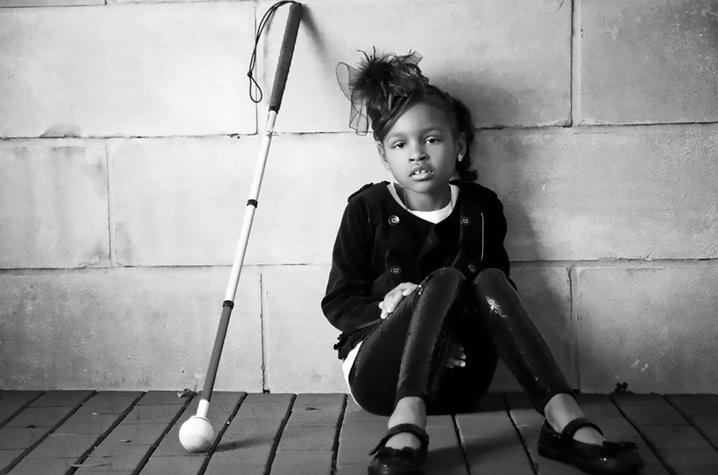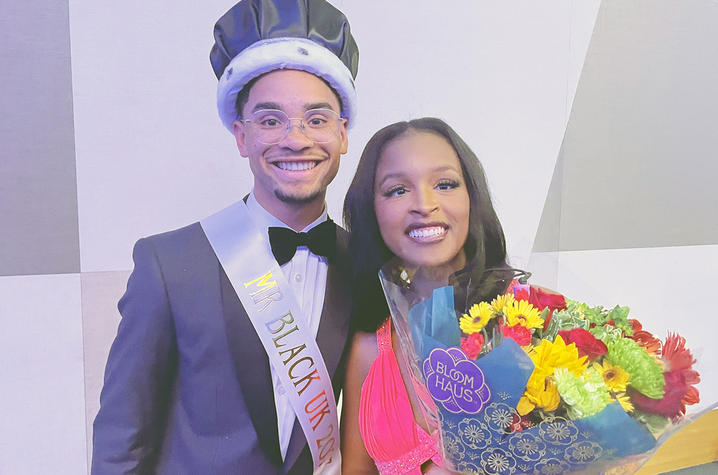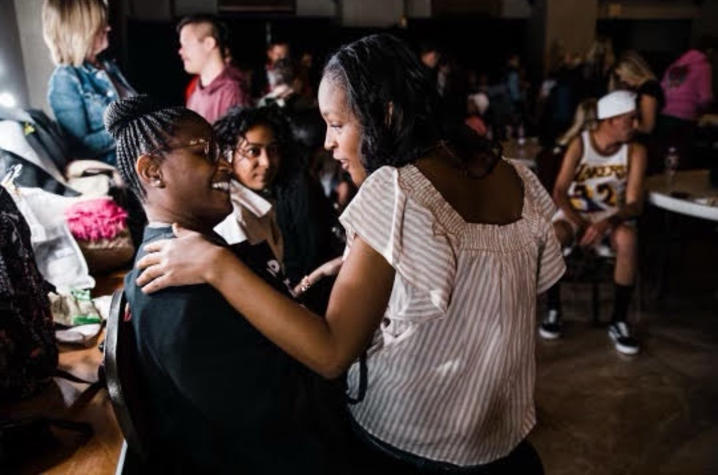Runway renegade
LEXINGTON, Ky. (Dec. 5, 2023) — For most budding fashionistas, accessories serve to complete an outfit. Many insist on the right handbag, the perfect patent-leather stiletto or some glistening bangle to bring a look together. TaMyah Jordan’s must-have accessory, however, is less about fashion than practicality: a five-foot collapsible cane in the shade of laundered cotton.
Jordan is profoundly visually impaired, and for two-thirds of her life, she has used her cane to safely navigate cities, large and small, access public transportation and even lead her down the fashion catwalks of major retailers. Now, she uses the cane to make her way across the University of Kentucky campus, where she prepares to one day design the fashions she has modeled for the past decade with a twist. The first-year trendsetter plans to create chic, inclusive, accessible fashions that anyone — especially those with vision difficulties — can wear with confidence.
“I want to make clothes that are easier for visually impaired people to identify what they’re putting on — what the color is, what the size is, what’s the front and what’s the back,” Jordan explains. “Those aren’t the things the average person thinks about while shopping.”
With more than one million people who are blind in the U.S. alone — and millions more with significant vision impairment — adaptive fashion is a booming segment of retail apparel. Mainstream brands such as Tommy Hilfiger, Kohl’s and Seven7 have all jumped into the $50-plus billion annual market for accessible clothing for individuals with sensory, physical and developmental disabilities.
“More and more, fashion is being pushed to look outside of its long exclusive ways and not only acknowledge that fashion is for everyone but to also create the clothing that makes it accessible to everyone,” says Tara Donaldson, executive editor at industry-bible Women’s Wear Daily and head of diversity, equity and inclusion for Fairchild Media Group in New York. “There are people who are fighting for recognition and representation, calling on brands to create more adaptive clothing, or creating it themselves when they can’t find what they need, or what their loved ones need. These people, to me, are the industry’s changemakers, the people who are filling a hole not just with more product, but more considered product.”
Jordan knew people would scoff when she enrolled at UK this fall in the Martin-Gatton College of Agriculture, Food and Environment’s Merchandising, Apparel and Textiles program. Only a handful of designers who are blind, such as Australian Nikki Hind, Sri Lankan Ashcharya Peiris, Cameroonian Mason Ewing and the late Ukrainian Sergey Ermakov, have created labels that have become part of the contemporary fashion discussion. Jordan pays the detractors no mind; she has a passion for fashion that emerged at an early age.
Born and raised near Nashville, Tennessee, Jordan lost her sight in the span of 24 hours from bilateral optic atrophy caused by a rare, previously undetected brain tumor known as pilocytic astrocytoma. She was 6. She does not have vivid recollections of that snowy day — Feb. 9, 2011 — only those from the repeated retellings she has heard.
“I was in my kindergarten class, and suddenly, I couldn’t see the whiteboard. It was blurry. I moved closer, then I couldn’t see it at all,” she recounts. “We went to an eye specialist. Multiple doctors were called in. They kept doing different tests, and then they said, ‘She has a brain tumor; she’ll be blind in the morning.’”
The trauma of her sudden blindness was tempered by life skills learned from her hero: her mother, Tonika East, Ed.D., a former pre-kindergarten special education teacher for the Metro Nashville Public Schools and an expert in job training for people with disabilities.
“Of course, to hear your child’s going to be blind tomorrow and there’s nothing for you to do — that’s hard,” Jordan says. “But my mom worked in vocational rehabilitation, so she was used to working with people with all kinds of disabilities.”
Buoyed by their faith that a higher power had an unrevealed purpose for their daughter, Jordan’s parents enrolled her in a school specializing in educating blind children. Beginning at age 7, Jordan awoke at 3:15 a.m. daily to catch the three-hour bus ride to the Tennessee School for the Blind in Nashville. Through their choices and actions, her parents impressed upon her the value of self-reliance.
“One of the hardest decisions for us as parents was to send her three hours away,” says East, now the director of lifelong learning in the Kentucky Office of Adult Education. “It was important for TaMyah to do the things that she did before she lost her sight. At the regular school, everybody wanted to do everything for her, but TaMyah needed to figure out how to do things on her own. I still tell her, ‘Society doesn’t feel sorry for you. Mean kids are going to be mean adults. Don’t try to change people and just live your best life.’ She walks with grace. She doesn’t complain at all.”
Despite her visual challenges, Jordan excelled academically and in activities alongside her sighted friends. She pirouetted with abandon onstage in tulle-covered skirts, sold Thin Mints and Samoas for her Girl Scout troop and later joined her school’s cheerleading squad and track and field teams.
At age 8, she appeared in an American Girl Fashion Show in Nashville. From there, her interest in fashion blossomed. In the ensuing decade, she has worked runways in New York and Los Angeles, represented brands such as Target and Meijer and advised Victoria’s Secret with her perspective on their recently released line of adaptive intimates.
In 2020, when her school shut down due to the COVID-19 pandemic, Jordan moved to Frankfort, where her mother accepted a position. As she prepared to graduate from the Kentucky School for the Blind in Louisville, Jordan’s thoughts turned to college and following her sartorial aspirations.
Jordan chose to attend UK for a myriad of reasons. She cites the university’s abundance of available disability services as a significant factor. She also received numerous scholarships — including the coveted Elmer S. “Shucks” Stafford Memorial, the Dorn Family and the William C. Parker Scholarships, among others — to help finance her education.
“I’ve been able to come to UK and not have debt,” Jordan says. “This generosity has allowed me to go where I want to go and do what I want to do without obstacles. My mom always told me, ‘Don’t let money be the reason why you don’t attend a specific school.’ But you’ve got to think, ‘Well, I’ve still got to pay for it,’ so the scholarships have greatly helped.”
Jordan is still settling into her life as a college student. In between her rigorous course load, she is getting involved in campus activities. She has joined UK’s chapters of College Mentors for Kids and Minorities in Agriculture, Natural Resources and Related Sciences. In October, she entered the Ms. Black UK pageant. She spends her free time listening to the latest hits by Ariana Grande and The Weeknd, shopping for clothes at area boutiques and playing music trivia. Even though she says movies often bore her to the point that she falls asleep, she enjoyed “seeing” "Barbie" in theaters with her friends.
While many contemplate how a visually impaired individual can navigate the visually intensive domain of fashion design, others similarly question the choice of a blind person to attend a movie. Without presuming to speak for others, Jordan unreservedly addresses inquiries about her impairment and her methods for overcoming challenges.
The word “blind” is slightly misleading. For Jordan, blind denotes complete darkness. She prefers to use the phrase “visually impaired.” She has light perception and can distinguish outlines and shadows. Depending on the ambient lighting, she can differentiate some colors. Using the terminology “visually impaired” opens the conversation for others to ask questions.
“I’m very open; I want to be able to let people know that it’s okay to ask me those questions you can’t ask anyone else. If I just say, ‘I’m blind,’ the first thing you think is I can’t see anything at all, just darkness,” reasons Jordan. “But that’s not my vision. If I use ‘visually impaired,’ it makes you open to ask the question, ‘Well, what can you see?’”
With this information, people begin to understand why Jordan’s favorite clothes are purple “with ruffley sleeves” and, hopefully, embellished with sequins, rhinestones or paillettes that will provide visual stimulation from the dancing light. They learn how she uses her limited perception and strips of tape on the floor during fashion shows to avoid tumbling off the catwalk. They come to understand how her enhanced memory aids her in navigating daily life, enabling her to distinguish and identify individuals — even from across the room — by their distinct voices and, with the aid of an audio description device, tap into memories to “see” movies.
As the demands of her fashion studies begin to monopolize her time, she is resigned that she may have to turn down future modeling opportunities. She intends to make her mark in a burgeoning area of accessible ready-to-wear clothing with an atelier that actively cultivates personal customer relationships.
Jordan already anticipates the opportunities that await her. She is eager to leverage study abroad opportunities in Italy and Paris, channeling her knowledge into clothing that promotes comfort and self-assurance for all.
“From what I can see of her background and ambitions, TaMyah is someone who will make change,” Donaldson adds. “While her physical vision may not be the same as others in this world, no one can discredit her vision for design, her vision for clothing that works for people of all abilities, her vision for an industry that brings everyone in instead of leaving them out.”
Jordan believes that, through fashion, she can change perceptions about what it means to have limited sight.
“A person with a visual impairment isn’t any less capable than anybody who’s fully sighted,” Jordan says. “We’re all capable of doing anything we want to do.”
As the state’s flagship, land-grant institution, the University of Kentucky exists to advance the Commonwealth. We do that by preparing the next generation of leaders — placing students at the heart of everything we do — and transforming the lives of Kentuckians through education, research and creative work, service and health care. We pride ourselves on being a catalyst for breakthroughs and a force for healing, a place where ingenuity unfolds. It's all made possible by our people — visionaries, disruptors and pioneers — who make up 200 academic programs, a $476.5 million research and development enterprise and a world-class medical center, all on one campus.









